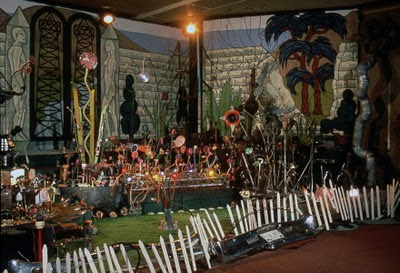 |
| Graphic from the poster/program/mailer designed by Art Chantry |
In 1992, I curated the Seattle portion of COCA's "Media to Metaphor: ART ABOUT AIDS," the traveling exhibit originally organized by Robert Atkins and Thomas W. Sokolowski for Independent Curators, Inc. in New York City. This was an extensive broad ranging production including the gallery exhibit, 16 window installations, a video program, projections on SAM, a panel discussion, a cabaret benefit and a DJ dance party. I worked with two graphic designers to pull this all together into the poster/program/mailer: Art Chantry did the main graphic (above), and Julia Field designed the program piece and helped me to organize my thoughts and the benefit for Babes.
Artists in the gallery exhibition:
Curated by Independent Curators, Inc.: (Art)ⁿ, Ross Bleckner, Kathe Burkhart, Nancy Burson, Steven Evens, General Idea, Felix Gonzales-Torres, Gran Fury, Kieth Haring, Adrian Kellard, Peter Kunz-Opfersei, Rudy Lemcke, Robert Mapplethorpe, Paul Marcus, Duane Michaels, Donald Moffett, Frank Moore, Ellen B. Neipris, Diane Neumaier, Nicholas and Bebe Nixon, Gypsy Ray, Rod Rhodes, Jane Rosett, John Sapp, Dui Seid, Jo Shane, Rosalind Solomon, Masami Teraoka, Max (Torque) =, Doug [(Bruno) Hammett], Kathy Vargas, Brian Weil, David Wojnarowicz, Thomas Woodruff.
Curated by Carl Smool: Juan Alonso, Fred Birchman, Tom Cantwell, Cheryl Comstock, Marita Dingus, Michael Ehle, Kevin Harvey, David Hartz, Sylvain Klause, Mary Molyneaux, Nancy Morrow, Barbara Quah, Grego Rachko, Kathy Ross, Harriet Sanderson, Wicktor Sandowicz, Tom Schworer, T. Ellen Sollod, Tom Thein and David Wickland, Peter Toliver, Mike Walsch, Alice Wheeler.
I wanted to expand the exhibition beyond the gallery, and so chose 16 artists to create window installations in neighborhoods including Downtown, the International District, the Rainier Valley, the Central District, Capitol Hill, the University District and in Kirkland.
Artists in the Window Project:
John Chapman, Jessica Klein, Alan Lande, Robert Yoder, Timothy Siciliano, Terry Amidei, Ted Link, Don Howe, Jill Beppu/Dan Neish, Jack Shields/Scott Fogdall (Heart to Art), Ron Travelletti, Skip Wright, Frank Video, Wicktor Sandowicz
 |
| Program statements from COCA and myself. |




















































